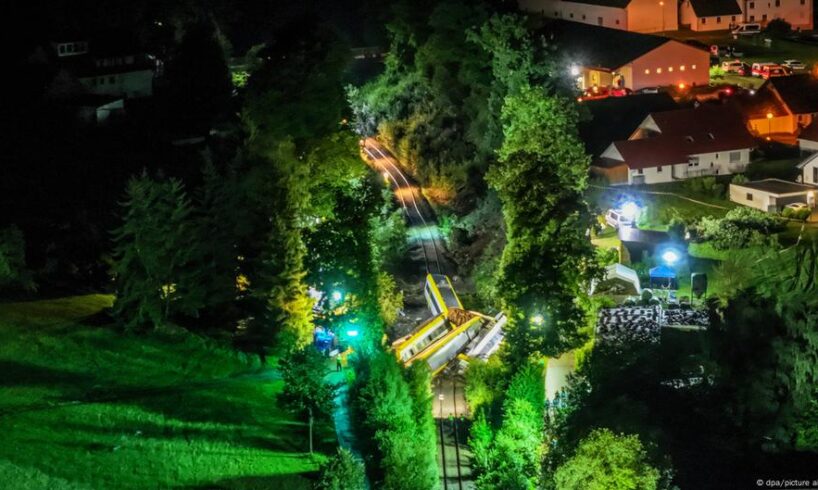
Emergency services were met with a scene of destruction. On Sunday evening, the grey-yellow cars of a regional train had derailed and crashed into each other near Riedlingen in southwestern Germany.
It soon became clear that the train driver, a trainee, and one passenger were killed in the accident. More than 40 out of around 100 passengers were injured, some of them seriously.
Heavy rain in the area had apparently caused a sewer shaft to overflow, triggering a landslide directly onto the railway line and derailing the train.
As man-made climate change increases the frequency of heavy rain, storms and other extreme weather events, railways are increasingly affected.
Heavy rain has caused the train to derail on Sunday, July 27Image: Thomas Warnack/dpa/picture alliance
Trains still cleaner and safer than cars
Overall, however, traveling by train is not only more sustainable than flying, it is also far safer than driving cars. Moreover, in recent years, the EU region has seen a decline in fatalities from train accidents.
To prevent landslides and flooding of road underpasses during heavy rainfall, the German railway company Deutsche Bahn has been working on a heavy rainfall plan: When water damages a section of railway, it is usually detected before the next train approaches.
Flooding has been a serious problem in the past, for example, with the 2021 flood disaster in the Ahr Valley in western Germany and neighboring regions, which killed 185 people.
The railway lines through the Ahr Valley and the neighboring Eifel mountain range still remain partially closed to traffic. On the Ahr river, the floods destroyed a total of 15 railway bridges. Several bridges in the Eifel region need to be rebuilt.
New bridges are being designed to better withstand extreme weather. The new structures will largely do without central pillars, to reduce exposure to water pressure and debris during floods.
A large part of the investment of around €500 million ($578m) is being spent on the electrification of two lines, which were previously served by diesel engines.
Once the electricity for the electric trains comes from renewable energy sources, they will emit significantly less greenhouse gases than diesel locomotives.
New bridges in the Ahr valley are being designed to be more resilient to climate changeImage: Marc John/Bonn.digital/picture alliance
How to safeguard trains from fire and strong wind?
However, this year’s early summer was marked less by rain than by periods of heat and drought in large parts of Germany. The resulting forest fires and fires along the railroad infrastructure forced connections to be cancelled or rerouted.
To mitigate this, railway teams regularly trim vegetation in a six-meter-wide corridor along the tracks.
Until 2023, Deutsche Bahn used the controversial herbicide glyphosate, whereas now it uses the less environmentally harmful pelargonic acid.
Since 2024, Deutsche Bahn has been testing whether fire risk can be minimized by watering embankments with specially equipped trains. This technique is primarily intended for use during hazardous tasks, such as welding work on rails during drought periods.
Train traffic is also at risk from strong winds that can bring down trees from outside the six-meter safety zone. These trees are monitored by Digital Vegetation Management, the railway’s AI system. Fed with satellite images and video recordings of specific routes, it is designed to issue warnings of potentially dangerous trees.
A hotter climate triggers more faults on the line
In order to adapt its infrastructure to climate change, the German railway company also sought advice from the Potsdam Institute for Climate Impact Research.
According to a study published shortly before the 2021 Ahr Valley floods, on days with temperatures above 30 degrees Celsius (86 Fahrenheit), there are on average 4.1 more fault reports in each of Germany’s 34 regional railway districts than on days below 30 degrees. At temperatures above 32 degrees, this figure rises to 5.1 more fault reports.
In the past, extreme heat even caused rails to bend. On July 28, 1969, a connection running between West Germany’s Düsseldorf and Leipzig in the former East Germany derailed about 40 kilometers from the inner-German border, killing four people.
At the time, rails were built and fastened in a way that allowed the steel to expand in all directions at high temperatures.
The tracks between West Germany’s Düsseldorf and Leipzig in the former East Germany bent in July 1967 and the resulting accident killed four peopleImage: Wolfgang Weihs/dpa/picture alliance
Nowadays, rail tracks can only expand up and down. In Italy, tracks are even painted white on their sides so that they absorb less heat from sunlight than conventional rail tracks, which develop a rust-brown color over the years.
According to Deutsche Bahn, temperatures of up to 60 degrees Celsius (140 Fahrenheit) pose no problem for the rails themselves. Only flexible parts such as switches must be cooled and as part of the “Climate-Resilient Railway Technology” program, components in signalling technology are also to be made more resistant to the increasing periods of heat.
Heat is also a problem for the train and its passengers. Engines can overheat, and air conditioning systems can be pushed to their limits.
The latest generation of ICE 4 express trains has two independent air conditioning systems in each car to keep the passenger compartment climate-controlled. They are designed to work just as well in outside temperatures of -25 degrees as they do on hot days of +45 degrees.
Multiple dead in train crash in southern Germany
To view this video please enable JavaScript, and consider upgrading to a web browser that supports HTML5 video
This article was originally published in German.





